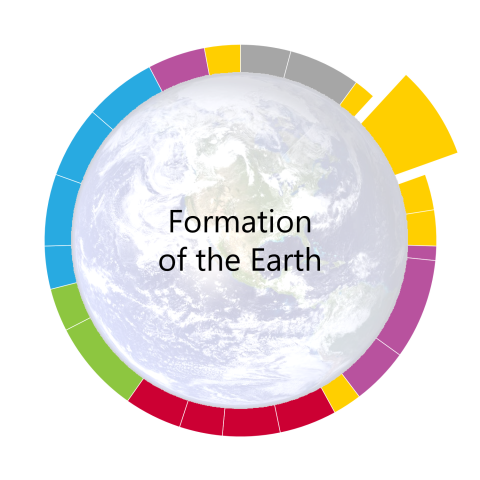Welcome to the first full model of the year for MBER's earth science-integrated biology!

Phenomenon
The Earth is a unique planet, even among its neighbors in the inner solar system, having not only a rocky structure but also oceans, an atmosphere and life!
Question
How did earth get all of the unique features that we described in our list? Where did all of these features of earth come from? How did these various spheres (i.e. geosphere, biosphere, hydrosphere, atmosphere) of earth form?
Driving Question for this Unit:
How did the rocky Earth (the geosphere) initially come to be?
Model Ideas
- Earth formed when many small space rocks collided and came together.
- When meteors (space rocks) combine, their masses add together.
- Gravity increases when 1) the mass of an object increases and/or 2) when the distance between two objects decreases.
- More gravitational attraction caused more collisions as proto-Earth gained mass.
- As more and more nearby space rocks collided with the Earth, the number of nearby space rocks decreased.
- Collisions of space rocks with planets and space rocks with space rocks convert kinetic energy into heat. Increases in the mass or velocity of the objects increases the heat generated during impact.
- As proto-Earth was forming, there were so many collisions producing heat that the solid rocks melted into liquid.
- The proto-Earth was a sphere of lava being constantly hit (and heated) by more space rocks.
- As space rocks decreased in number, there were fewer collisions so the cold empty vacuum of space cooled proto-Earth down. The parts of Earth closest to the surface cooled down first, while the deepest center of earth remained molten rock.
Overview
Transition In: Having realized that Earth is a changing system that may be in peril, we turn toward an exploration of what makes the Earth unique and how it got to be that way.
After generating two lists-- one with characteristics Earth shares with other planets and another that it does not-- we wonder how our unique planet came to be. We decide the first step is to explore the formation of the Earth's rocky geosphere since we wonder if the inner, rocky planets may have all formed in a similar manner. A specific common feature among the inner planets--craters--gives us a place to start exploring our model. Through a lab, we recognize that meteor impacts hold the potential to add mass to a planet as well as a significant amount of energy. This leads us to think that Earth may have formed from the accretion of meteors, dust and gas during the formation of the solar system. The result was a massive planet whose formation accelerated due to gravitational capture of more space rocks over time. As space rocks declined in number (as planets accumulated their mass), the number of impacts declined, Earth cooled and formed a rocky crust atop a molten interior.
Transition Out: After developing a model for the formation of the geosphere, we turn our attention to the other aspects of Earth, the ones that make it more pointedly unique--the atmosphere, the oceans, and life. How did these originate?
Advanced Planning
There are a number of labs, simulations and demos in this unit (and one mathematical calculation) that will require preparation. Please see the teacher guides for each activity for details. Additionally, we've provided a supplemental teacher guide devoted to "Building the Model". You should read this guide as part of your preparation for the unit: this is the first model you will build in earnest with your students, yet in this rather large unit, we don't formally generate the model until Learning Segment 08. The guide will help you to track ideas with your students as you work toward that important moment.
Please also see consider the Earth Science Guides referenced in the teacher slides in the PowerPoint. For this unit, there are three that are particularly germane: Meteors (LS 03), Accretion (LS 04), and Gravity (LS 09).
Download Resources
| Attachment | Size |
|---|---|
| Formation of the Earth PowerPoint (and embedded Teacher Manual) | 44.3 MB |
| All Other Resources for Formation of the Earth | 48.1 MB |